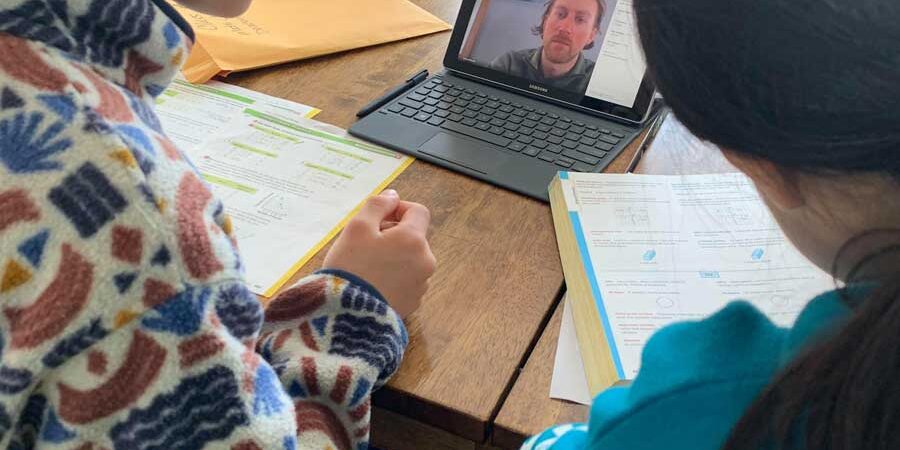As the current school year draws to a close, educators across Alaska have been utilizing different forms of distance instruction, including a model based on the Florida Virtual School. However, for schools in Western Alaska, KNOM’s Joe Coleman explains that using that educational method may not be as practical.
The State of Alaska moved quickly to adopt Florida’s virtual education model and opened registration for students on March 31st, as approved by Governor Mike Dunleavy’s administration. This followed former Florida Governor, Jeb Bush’s recommendation to Alaska Commissioner of Education Dr. Michael Johnson. Their decision was met with mixed responses.
“Commissioner Johnson wanted to be able to offer options basically that would be free of charge for schools and for families…”
– Tammy Vanwyhe
Tammy Vanwyhe, Division Director for Innovation and Education Excellence at the Department of Education and Early Development, explains some of the benefits of the virtual school model.
“There are a lot of different statewide correspondence programs in the state of Alaska, but they all require enrollment, so a student has to basically unenroll from the local school to enroll in one of the correspondence programs.”
– Tammy Vanwyhe
The Florida Virtual School model would not require that students leave their current schools to enroll in this one. While there can be benefits for certain Alaska students, there is the worry that this model won’t be beneficial for rural schools off the road system.
Nome-Beltz Social Studies teacher Aaron Blankenship, who spent some time in online school himself, sees some positive uses for it.
“There’s a subset of students who work really well self-paced, on their own, and this model of education can be really good for them if it’s rigorous, if they’re provided the support and accommodation they need, if the learning is developed to them.”
– Aaron Blankenship
However, Blankenship also has concerns with the speed in which Alaska’s newest virtual option is being implemented.
“The problem is though, that takes a lot of development. As teachers right now are finding out, rebuilding your curriculum isn’t something that happens in a week and it’s not something that happens in a month.”
– Aaron Blankenship
He isn’t alone. Nome Public Schools Superintendent Jamie Burgess has her own concerns about Nome students switching to a virtual school model and losing cultural context.
“One of the really key things for our kids to be successful here, I really believe, is that the curriculum truly has to be relevant to them. And [in] most of these courses, there’s no personalization, there’s no consideration of cultural needs and relevance to our community.”
– Jamie Burgess
Instead, Superintendent Burgess has an alternative she would prefer to use.
“I think that the better solution for our kids, for online learning, would be for us to have the opportunity to develop our own content and our own teachers with expertise in online learning.”
– Jamie Burgess
Concerns over the virtual school model are not limited to just the furthest reaches of the Last Frontier either. Association of Alaska School Boards‘ Executive Director, Norman Wooten, says that AASB and the Department of Education and Early Development (DEED) have been in constant contact about this topic.
There is still a cultural concern statewide regarding the virtual school model from Florida.
“I think that we have the capacity from a number of school districts in the state of Alaska to offer the same program that is more culturally relevant to the kids in Alaska through a virtual or a homeschool distance-delivery model, for those parents who choose that, and for those schools who choose to supplement their face to face teaching with virtual.”
– Norman Wooten
Tammy Vanwyhe assures Alaska-based educators that the use of teachers from the Florida Virtual School Model is just a temporary measure and no Alaskan jobs are at stake.
“That’s just for the first phase – we’re calling them the ‘COVID classes,’ so these courses that basically cover the last nine weeks of the school year, and were meant to help fill in the gaps and provide resources to educators[…]”
– Tammy Vanwyhe
This model can, however, help students additionally maintain some level of normalcy in their educational tract. Students can potentially use this as a way to minimize their remedial needs.
While the method for educating during the next school year is unknown, DEED plans to have Alaskan students fully taught by Alaskan teachers in the fall of the 2020-2021 school year. The department also notes that utilizing this virtual school program is optional, citing concerns for feasibility in schools in the Western half of the state. Here’s Nome’s Superintendent Burgess:
“I think if we look ahead to next year there might be some teachers that have an interest in developing those skills and maybe look at exploring ‘what can we do?’ There’s a lot of things we can do with the platform that we have available if we feel that there is a need or a desire for some students to look at more fully online classes.”
– Jamie Burgess
Choosing to not opt into the virtual school model will not negatively impact state funding for Nome Public Schools nor will there be state-instituted consequences. School districts and families have full autonomy to choose the distance delivery model they believe will be most effective going forward.
Based on KNOM’s conversations with various educators for this story, there seems to be potential confusion over enrollment. While other correspondence programs require students to un-enroll in their current schools to enroll in a virtual model, the Florida model can be used by a student in conjunction with their enrollment in a local, physical school.
Image at top: Nome Public Schools’ students using their newfound internet access to work on local school assignments. Photo courtesy of Kawerak and Rebecca Callahan, used with permission (2020).




